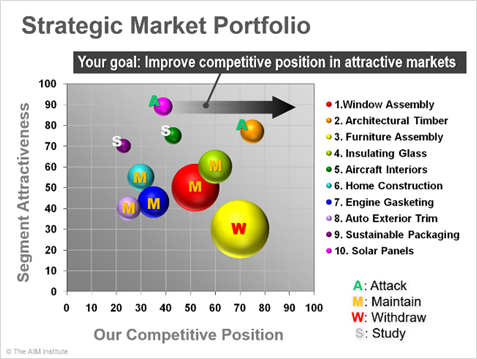Use Blueprinting to understand your "attack" and "study" strategic market segments.
Let’s say you’ve created a GE-McKinsey matrix, with your market segments positioned for segment attractiveness vs. your competitive position. The role of New Product Blueprinting in strategic planning becomes quite simple: Apply Blueprinting to your “Attack” and “Study” markets.

This is a virtuous cycle. Your strategic planning determines the markets you’ll pursue with Blueprinting projects. Then next year, your strategic planning is informed by what you learned in your Blueprinting projects. What can change from year to year in this process? A lot! Here are some examples:
- Less attractive: We thought this market segment should be a great target for growth. But our Market Satisfaction Gap results showed this market is over-served… satisfied with what it now has and therefore only wants lower prices.
- More attractive: Our interviews revealed that this market has some enormous unmet needs… and the market is quite willing to pay for them. We’re going to add even more resources to this market segment to accelerate penetration.
- New competencies: This did turn out to be a very attractive market. But in order to address the outcomes customer desire the most, we will need competencies we lack today… so we are going to adopt an acquisition strategy for this.
- Competitive landscape: We learned that this market is dominated today by a “800 pound gorilla.” All indications from our interviews say this competitor is highly focused on this market and is willing to defend it aggressively. The market looks much less attractive to us now.
- Forward integration: As we interviewed down the value chain, we realized the greatest value can be generated not by our products… but by our customers’ products. We will change our business model to sell an entire system instead of just our ingredient or component.
- New business model: Perhaps we had been selling a physical product and our Blueprinting work showed us we need to "wrap" a suite of services around it. So instead of just selling pumps, we use the internet-of-things to offer flow monitoring, maintenance planning, and liquid stream analysis.
- Refined segmentation: We thought this was a single market segment, but we learned there are three discrete market segments. Our competitors have missed this fact. We will focus on meeting the needs of these “sub-segments” to deliver innovation lacking today.
Keywords: strategic plan, strategic market portfolio, GE-McKinsey, strategy, strategic market segments, attack, maintain, withdraw, study, New Product Blueprinting
